 W
WAsus ZenFone is a series of Android smartphones designed, marketed and produced by Asus. The first-generation ZenFones were announced at the 2014 Consumer Electronic Show in Las Vegas, Nevada. In addition to its Intel Atom, Qualcomm Snapdragon, and MediaTek processors and the Android operating system, some ZenFone also features the Zen UI, a user interface from Asus.
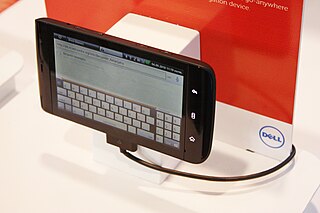 W
WDell Streak 5 is a smartphone/tablet hybrid ("phablet") from Dell that uses the Android operating system. It comes with a 5-inch (13 cm) capacitive touchscreen and two cameras, a 5MP one with dual-LED flash on the back and a VGA-resolution one on the front for video calling; both are capable of video. The development was first disclosed in June 2009 and in October 2009 it was known that the tablet was capable of making 3G phone calls.
 W
WThe Honor 9 is a smartphone made by Huawei under their Honor sub-brand. It is a successor of the Huawei Honor 8 within the Huawei Honor series.
 W
WThe HTC One Max is an Android phablet smartphone designed and manufactured by HTC. The device is a larger variant of HTC's 2013 flagship high-end smartphone, the HTC One, notably incorporating a 5.9-inch display and fingerprint recognition features.
 W
WHuawei Mate 20 is a line of Android phablets produced by Huawei, which collectively succeed the Mate 10 as part of the Huawei Mate series. The flagship models, the Mate 20 and Mate 20 Pro, were unveiled on 16 October 2018 at a press conference in London.
 W
WThe iPhone 6 and iPhone 6 Plus are smartphones designed and marketed by Apple Inc. They are the eighth generation of the iPhone, succeeding the iPhone 5S, and were announced on September 9, 2014 and released on September 19, 2014. The iPhone 6 and iPhone 6 Plus jointly were themselves replaced as the flagship devices of the iPhone series by the iPhone 6S and iPhone 6S Plus on September 9, 2015. The iPhone 6 and 6 Plus include larger 4.7 and 5.5 inches displays, a faster processor, upgraded cameras, improved LTE and Wi-Fi connectivity and support for a near field communications-based mobile payments offering.
 W
WThe iPhone 6S and iPhone 6S Plus are smartphones that were designed, developed, and marketed by Apple Inc. It is the ninth generation of the iPhone. They were announced on September 9, 2015, at the Bill Graham Civic Auditorium in San Francisco by Apple CEO Tim Cook, with pre-orders beginning September 12 and official release on September 25, 2015. The iPhone 6S and 6S Plus were succeeded by the iPhone 7 and iPhone 7 Plus on September 7, 2016 and were discontinued with the announcement of the iPhone XS, iPhone XS Max, and iPhone XR on September 12, 2018.
 W
WThe iPhone 7 and iPhone 7 Plus are smartphones designed, developed, and marketed by Apple Inc. They are the tenth generation of the iPhone. They were announced on September 7, 2016, at the Bill Graham Civic Auditorium in San Francisco by Apple CEO Tim Cook, and were released on September 16, 2016, succeeding the iPhone 6S and iPhone 6S Plus as the flagship devices in the iPhone series. Apple also released the iPhone 7 and iPhone 7 Plus in numerous countries worldwide throughout September and October 2016. They were succeeded as flagship devices by the iPhone 8 and iPhone 8 Plus on September 22, 2017.
 W
WThe iPhone 8 and iPhone 8 Plus are smartphones designed, developed, and marketed by Apple Inc. They make up the 11th generation of the iPhone, along with the iPhone X. They were released on September 22, 2017, succeeding iPhone 7 and iPhone 7 Plus. The iPhone 8 and iPhone 8 Plus were discontinued by Apple on April 15, 2020 with the release of the second-generation iPhone SE.
 W
WThe iPhone XS and iPhone XS Max are smartphones designed, developed and marketed by Apple Inc. They are the twelfth-generation flagships of the iPhone, succeeding the iPhone X. Apple CEO Tim Cook announced the devices alongside a lower-end model, the iPhone XR, on September 12, 2018, at the Steve Jobs Theater at Apple Park. Pre-orders began on September 14, 2018, and went on sale on September 21.
 W
WThe LG G Flex is an Android phablet developed and manufactured by LG. First unveiled by the company on October 27, 2013 for a release in South Korea, and carrying similarities to its G2 model, the smartphone is the company's first to incorporate a flexible display, along with a "self-healing" rear cover which can repair minor abrasions on its own.
 W
WThe LG G Pro 2 is an Android phablet smartphone produced by LG Electronics. Serving as a successor to the LG Optimus G Pro, it was unveiled in February 2014 during the 2014 Mobile World Congress in Barcelona, Spain. The phone comes in white or black. It has two RGB notification LEDs, one on the front and another on the back in the power button. It also supports the SlimPort video out standard.
 W
WThe LG Gx is an Android smartphone developed by LG Electronics. It serves as an update to LG's phablet, the 2012 LG Optimus G Pro, by updating the software and design to that of LG's new flagship, the 2013 LG G2. Other than that, the smartphone is exactly the same as the LG Optimus G Pro with features that include LTE connectivity and an IR blaster, which allows use as a TV remote control. The handset has only been released in Korea on LG's own network, LG U+, as of 20 February 2014 and LG has not commented on whether it will become an international device.
 W
WThe LG Optimus G Pro is a flagship smartphone/phablet designed and manufactured by LG Electronics. It was released in the U.S. on May 10, 2013.
 W
WThe LG Vu 3 is an Android smartphone/tablet computer hybrid ("phablet"), released in September 2013 and noted for its 5.2-inch screen size—between that of conventional smartphones, and larger tablets. It is powered by a 2.26 GHz quad-core Krait 400 CPU with Adreno 330 GPU and runs on 4.2.2 Jelly Bean. 4.4.2 KitKat was also announced for update on 14 March, 2014.
 W
WThe Nexus 6 is a phablet co-developed by Google and Motorola Mobility that runs the Android operating system. The successor to the Nexus 5, the device is the sixth smartphone in the Google Nexus series, a family of Android consumer devices marketed by Google and built by an original equipment manufacturer partner. Nexus 6 along with HTC Nexus 9 served as the launch devices for Android 5.0 "Lollipop".
 W
WThe Nokia Lumia 1320 smartphone is a phablet smartphone in the Lumia series developed by Nokia that runs the Windows Phone 8 operating system. It was announced at the Nokia World event on October 22, 2013. It was released in Asia in the first quarter of 2014, including the India release in January 2014. It has 6-inch (150 mm) ClearBlack IPS LCD display, making it the biggest display for Windows phones along with the Nokia Lumia 1520.
 W
WThe Nokia Lumia 1520 was a flagship Windows Phone phablet smartphone designed and produced by Finnish telecommunications manufacturer Nokia in partnership with American software manufacturer Microsoft. The device was first announced at the Nokia World event on 22 October 2013 in Abu Dhabi, alongside its mid-range phablet stablemate the Nokia Lumia 1320 and Nokia's 10.1 inch Windows RT tablet the Nokia Lumia 2520. Until its discontinuation in the United States on 7 April 2015 the phone served as the flagship device for Nokia's Lumia Series and Microsoft's mobile effort. On 6 October 2015 Microsoft officially announced its flagship phablet successor, the Microsoft Lumia 950 XL, with availability sometime in November 2015.
 W
WThe OPPO R15 Pro is a phablet smartphone based on Android 8.1, which was unveiled in March 2018.
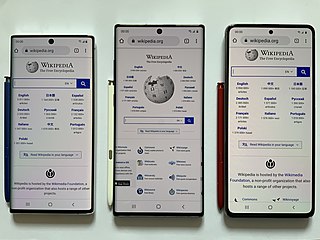 W
WThe phablet is a class of modern mobile devices combining or straddling the size format of smartphones and tablets. The word itself is a portmanteau of the words phone and tablet.
 W
WRedmi is a sub-brand owned by the Chinese electronics company Xiaomi. It was first announced in July 2013 as a budget smartphone line, and became a separate sub-brand of Xiaomi in 2019 with entry-level and mid-range devices, while Xiaomi itself produces upper-range and flagship Mi phones. Redmi phones use the Xiaomi MIUI user interface on top of Android. Models are divided into the entry-level Redmi, the mid-range Redmi Note, and the high-end Redmi K. In addition, the unrelated Mi A Android One series is also positioned in the similar market segment with Redmi devices, despite being part of the upper-range Xiaomi Mi lineup. The most significant difference from other Xiaomi smartphones is that they use less-expensive components and thus have lower prices while retaining higher specifications. In August 2014, The Wall Street Journal reported that in the second quarter of the 2014 fiscal year, Xiaomi had a market share of 14% of smartphone shipment rankings in China. Redmi sales were attributed as a contributing factor toward this gain in shipment rankings.
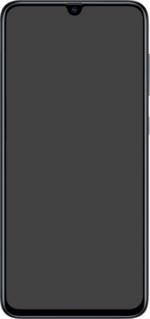 W
WThe Samsung Galaxy A70 and A70s are a series of Android phablets manufactured by Samsung Electronics as part of its fifth-generation Galaxy A series lineup. The phones come with Android 9 (Pie) with Samsung's proprietary One UI skin, 128 GB of internal storage, and a 4500 mAh battery. The A70 was unveiled in South Korea on April 19th 2020
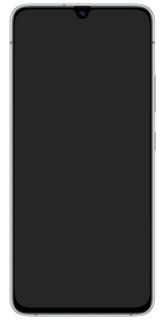 W
WThe Samsung Galaxy A90 5G is an Android phablet manufactured by Samsung Electronics as part of its fifth-generation Galaxy A series lineup. It comes with Android 9 (Pie) with Samsung's One UI skin, 6/8GB RAM, 128 GB of internal storage, and a 4500 mAh battery. It is Samsung's first mid-range smartphone to support 5G network connectivity. The Galaxy A90 5G was first unveiled in South Korea on September 3, 2019.
 W
WThe Samsung Galaxy M30s is an Android phablet manufactured by Samsung Electronics as part of its first-generation Galaxy M series lineup, as a successor to the Samsung Galaxy M30. The phone is shipped with Android 9 (Pie), Samsung's proprietary One UI skin, 64 or 128 GB of internal storage, and a 6000 mAh Li-Po battery. The M30s was released on 18 September 2019. It features a rear triple camera array composing of a 48 MP wide angle camera, 8 MP ultra wide angle camera, and a 5 MP depth sensor.
 W
WThe Samsung Galaxy Mega is an Android-based phablet that was manufactured and released by Samsung. It was announced on April 11, 2013. The original model featured a 6.3 in (160 mm) screen, though a revised version was released with a 5.8 in (150 mm) screen. It has a 1,280×720 screen, a dual-core 1.7 GHz processor and an 8-megapixel camera. The phone runs Android 4.2.2 "Jelly Bean" software, and internal storage is 8 or 16 GB.
 W
WThe Samsung Galaxy Note is an Android smartphone produced by Samsung Electronics. Unveiled at IFA Berlin 2011, it was first released in Germany in late October 2011, with other countries following afterwards. The Galaxy Note was distinguished by its unusually large form factor—later referred to using the term "phablet"—which straddled the size of the average smartphone at the time, and that of a small tablet: it features a 5.3-inch display, and is bundled with a stylus branded as the "S Pen", which can be used to navigate the device's user interface, and write or draw in supported apps.
 W
WThe Samsung Galaxy Note 3 is an Android phablet smartphone produced by Samsung Electronics as part of the Samsung Galaxy Note series. The Galaxy Note 3 was unveiled on September 4, 2013, with its worldwide release beginning later in the month. Serving as a successor to the Galaxy Note II, the Note 3 was designed to have a lighter, more upscale design than previous iterations of the Galaxy Note series, and to expand upon the stylus and multitasking-oriented functionality in its software—which includes a new navigation wheel for pen-enabled apps, along with pop-up apps and expanded multi-window functionality. Samsung has sold 5 million units of the Galaxy Note 3 within its first month of sale and broke 10 million units sales in just 2 months.
 W
WThe Samsung Galaxy Note 3 Neo is an Android phablet smartphone produced by Samsung Electronics. The Galaxy Note 3 Neo was unveiled by Samsung Poland on February 1, 2014, with its worldwide release later in that month. Serving as a lower priced version of the Samsung Galaxy Note 3, the Note 3 Neo was designed to have the same lighter, more upscale design than previous iterations of the Galaxy series first supported by its bigger sibling, and to expand upon the stylus and multi-tasking oriented functionality in its software, which includes the new navigation wheel for pen-enabled apps, along with pop-up apps and expanded multi-window functionality.
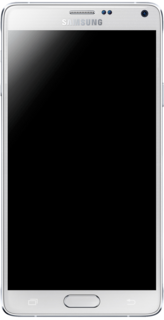 W
WThe Samsung Galaxy Note 4 is an Android smartphone developed and produced by Samsung Electronics. The Galaxy Note 4 was unveiled during a Samsung press conference at IFA Berlin on 3 September 2014 and was released globally in October 2014. It is the successor to the Samsung Galaxy Note 3. Its subsequent model, the Samsung Galaxy Note 5, was unveiled on 13 August 2015.
 W
WThe Samsung Galaxy Note 5 is an Android-based phablet designed, developed, produced and marketed by Samsung Electronics. Unveiled on 13 August 2015, it is the successor to the Galaxy Note 4 and part of the Samsung Galaxy Note series.
 W
WThe Samsung Galaxy Note 7 is a discontinued Android-based phablet designed, developed, produced and marketed by Samsung Electronics. Unveiled on 2 August 2016, it was officially released on 19 August 2016 as a successor to the Galaxy Note 5. It is Samsung's first phone with a USB-C connector, and the last phone in the Galaxy Note series to have a physical home button. Although it is the sixth main device in the Galaxy Note series, Samsung branded its series number as "7" instead of "6" so consumers would not perceive it as being inferior to the flagship Samsung Galaxy S7, and to prevent confusion about the order of release due to the same release year (2016).
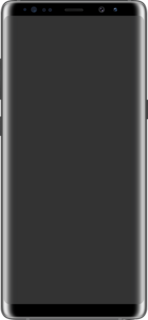 W
WThe Samsung Galaxy Note 8 is an Android-based smartphone phablet designed, developed, produced and marketed by Samsung Electronics. The successor to the discontinued Samsung Galaxy Note 7, it was unveiled on 23 August 2017 and became available on 15 September 2017.
 W
WThe Samsung Galaxy Note 9 is an Android-based phablet designed, developed, produced and marketed by Samsung Electronics as part of the Samsung Galaxy Note series. It was awarded the "Best Phone of the Year" award by Consumer Reports. It was unveiled on 9 August 2018, as the successor to the Samsung Galaxy Note 8. It is available in six colours.
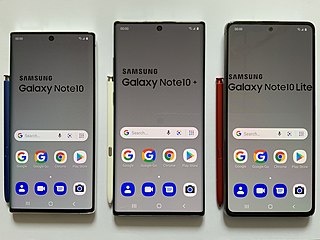 W
WThe Samsung Galaxy Note 10 is a line of Android-based phablets designed, developed, produced, and marketed by Samsung Electronics as part of the Samsung Galaxy Note series. They were unveiled on 7 August 2019, as the successors to the Samsung Galaxy Note 9. Details about the phablets were widely leaked in the months leading up to the phablets' announcement.
 W
WThe Samsung Galaxy Note 20 and Galaxy Note 20 Ultra are Android-based phablets designed, developed, produced, and marketed by Samsung Electronics for their Samsung Galaxy Note series, succeeding the Samsung Galaxy Note 10 series. The phablets were announced on 5 August 2020 alongside the Samsung Galaxy Z Fold 2, Galaxy Watch 3, Galaxy Buds Live and Samsung Galaxy Tab S7 during Samsung's Unpacked Event.
 W
WThe Samsung Galaxy Note Edge is an Android phablet produced by Samsung Electronics. Unveiled during a Samsung press conference at IFA Berlin on September 3, 2014 alongside its sister, the Galaxy Note 4, it is distinguished by a display that curves across the right side of the device, which can be used as a sidebar to display application shortcuts, notifications, and other information.
 W
WThe Samsung Galaxy Note II is an Android phablet smartphone. Unveiled on August 29, 2012 and released in October 2012, the Galaxy Note II is a successor to the original Galaxy Note, incorporating improved stylus functionality, a larger 5.5-inch (140 mm) screen, and an updated hardware and casing design based on that of the Galaxy S III.
 W
WThe Samsung Galaxy Note series is a series of high-end Android phablets and smartphone developed and marketed by Samsung Electronics. The line is primarily oriented towards pen computing; all Galaxy Note models ship with a stylus pen and incorporate a pressure-sensitive Wacom digitizer. All Galaxy Note models also include software features that are oriented towards the stylus and the devices' large screens, such as note-taking and digital scrapbooking apps, and split-screen multitasking. The line serves as Samsung's flagship smartphone model, positioned above the Samsung Galaxy S series.
 W
WThe Sony Xperia Z Ultra is a 2013 Android phablet designed and manufactured by Sony Mobile.
 W
WThe Xiaomi Mi A2 Lite is a budget smartphone developed by Xiaomi, a global version of the company's Redmi 6 Pro, co-developed by Google as part of its Android One project.
 W
WThe Xiaomi Mi CC9 Pro is an Android smartphone developed by Xiaomi. It is the world's first commercially available phone with a 108 MP primary camera.
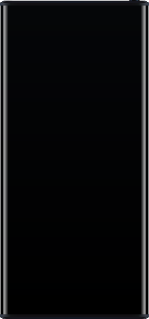 W
WThe Xiaomi Mi MIX Alpha is an Android-based smartphone designed by Xiaomi. Xiaomi describes it as a concept phone, but planned on bringing it into small-scale production. It was scheduled to be released in December 2019, but has been cancelled due to manufacturing complexities.